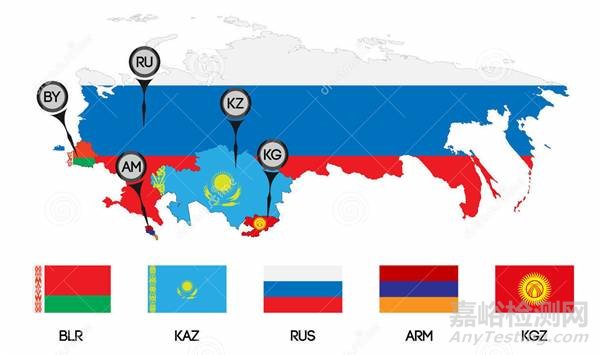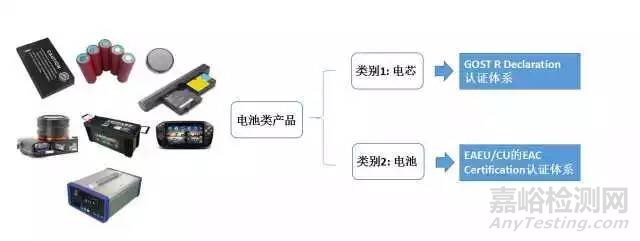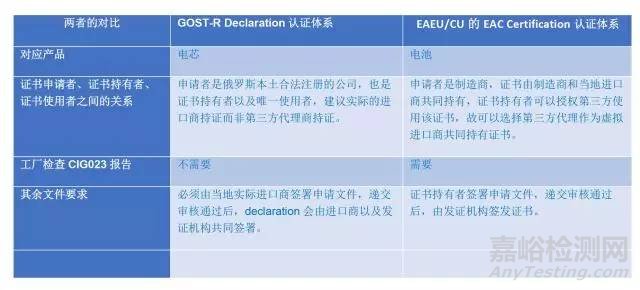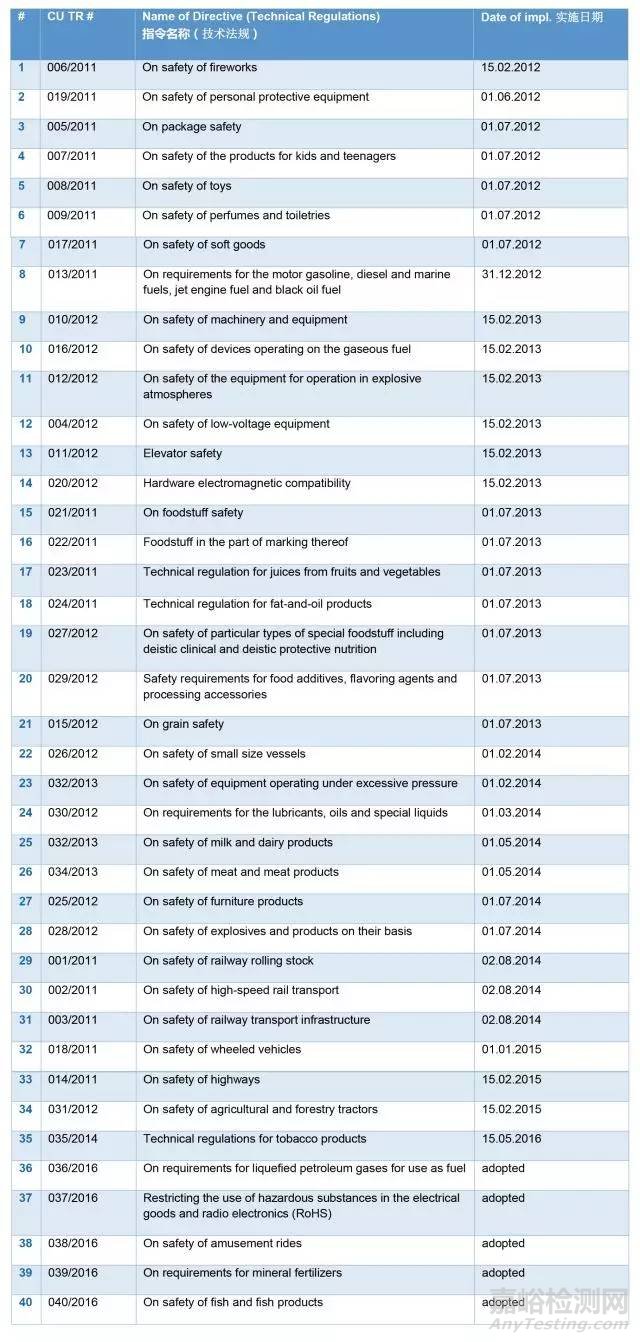您当前的位置:检测资讯 > 法规标准
嘉峪检测网 2017-06-16 09:14
欧亚经济联盟EAEU/CU EAC认证
欧亚经济联盟是中国周边重要的区域一体化组织,联盟成员国俄罗斯、白俄罗斯、哈萨克斯坦、亚美尼亚、吉尔吉斯斯坦五国均是中国开展贸易、投资,以及共建“丝绸之路经济带”的重要合作伙伴。了解欧亚经济联盟法律,对于开展中国与联盟及其成员国经贸合作具有重要意义。
2015年以来,欧亚经济联盟 (EAEU) 沿用其前身海关联盟 (CU) ,即原俄罗斯、哈萨克斯坦、白俄罗斯三国组成的海关联盟 (CU) 政策,对机械设备、交通工具、玩具等66大类商品实施强制技术规范管理,并将各国独立的认证证书改为统一的认证证书, 中国超过90%的输俄商品需申请该认证。
EAEU联盟成员国示意图
俄罗斯GOST R合格证书是在EAEU体系之前,确认产品符合俄罗斯安全法规的证明文件。在EAEU之后,对于EAEU还未公布相应技术规范的产品,还需符合俄罗斯本国的GOST R认证。
GOST R合格证书适用于: 在俄罗斯企业生产的产品或者是进口到俄罗斯的产品。
GOST R合格证书, 是一种用来证明认证产品是符合认证体系统法规, 确认该产品是与俄罗斯国家要求、适用标准的质量和安全要求相符的证明文件。产品证书针对有些产品是强制性的, 也有些是自愿的。
俄罗斯GOST R强制性证书分为:
1. GOST R合格证书
2. GOST R Declaration即GOST R符合性声明
第一步, 明确您的电池类产品类别,然后有的放矢。
类别1: 电芯, 即不含任何有源元件或者电路的电芯或者电芯模组。
类别2: 电池, 即含有源元件的电池或者电池包。
根据当前的欧亚经济联盟和俄罗斯的法规,类别1电芯的产品认证必须遵循GOST R Declaration 的认证体系,而类别2电池则必须在EAEU/CU的EAC Certification认证体系内。
第二步, 了解不同法规要求的认证流程的不同。
自2015年1月1日实施 “欧亚经济联盟” 协议以来,技术法规所要求的覆盖范围就从单个成员国层面上升到了欧亚经济联盟层面。
根据EAEU协议第52-53页中描述:对于那些在联盟技术法规内强制的产品,所有联盟国都应该保证并遵循EAEU法规的优先性。例如,假设电池产品的类别在EAEU的认证清单里,那么就需要根据EAEU的要求去申请Declaration或者Certification,并且在电池产品上印上EAC的标识。
具体见如下法规释义。
EAEU Contract (Pages 52-53)
Products, which have entered into force on technical regulations of the Union (technical regulations of the Union), is released into circulation on the territory of the Union, provided that it passed the required conformity assessment procedures specified in technical regulations of the Union.
From the date of entry into force of the technical regulations of the Union, in the territories of member States associated, mandatory requirements to products or to production and connected with requirements to production to designing processes (including surveys), production, construction, installation, adjustment, operation, storage, transportation, realization and utilization established by the legislation of the member States or acts of the Commission, act only in part, certain transitional provisions, and from the completion of the transitional provisions, certain technical regulations of the Union and (or) an act of Commission, do not apply for the release of products in circulation, assessment of conformity of objects of technical regulation, state control (supervision) over observance of requirements of technical regulations of the Union.
Mandatory requirements to products or to production and connected with requirements to production to designing processes (including surveys), production, construction, installation, adjustment, operation, storage, transportation, realization and utilization established by acts of Commission until the date of entry into force of technical regulations of the Union are included in the technical regulations of the Union.
类别1: 电芯, 即不含任何有源元件或者电路的电芯或者电芯模组。
没有任何有源电子电路的带电电池以及用于连接点亮设备的电池(电芯),即不带有源电子电路或者不含有源元件的电芯是不需要申请EAEU认证的。
如果不在EAEU 020/2012或者 018/2012指令里的电池(电芯)产品,我们应该参照EAEU协议Annex 9的指令,要判断是否需要申请成员国内单独的强制认证,比如GOST R(俄罗斯认证)。属于GOST R 认证体系内的电池(电芯)包括:
Battery for mandatory GOST R Approval (Declaration)
Battery classification:
3481 Batteries and battery acid
Batteries lead-acid starter (except those used for wheeled vehicles)*
Battery storage lead for motorcycles and scooters*
Batteries and battery acid open (unsealed) *
Batteries and battery acid closed (sealed) *
3482 Batteries and alkaline batteries
Batteries and batteries alkaline Nickel-iron*
Accumulators alkaline Nickel-cadmium sealed cylindrical
Accumulators alkaline Nickel-cadmium sealed disc
Accumulators alkaline Nickel-cadmium prismatic sealed
Batteries and batteries alkaline Nickel-cadmium closed (leaking)
Batteries and rechargeable batteries, Nickel metal hydride and lithium systems*
3483 galvanic cells and batteries
类别2: 电池, 即含有源元件的电池或者电池包。
EAEU关于EMC的020/2012 指令,其中就有描述如下:所有有可能引起电磁干扰的带电产品都需要按照020/2012来申请EAEC/CU EAC认证。意味着这个指令下的产品是指所有含有源电子电路或者有源元件的带电产品。有源元件包括—晶体管,芯片,二极管或者其他半导体元器件。即类别2电池需要申请EAEU认证。
根据EAEU指令 018/2012,作为车辆零部件的可充电电池也是需要做EAEU/CU 的EAC认证。
GOST R Declaration体系和EAEU的Certification体系一览表
我们总是被问到,为什么类别1电芯不被归为EAEU/CU的EAC Certification 范围呢?
原因一:详述到EAEC关于EMC的020/2012 指令,其中就有描述如下:所有有可能引起电磁干扰的带电产品都需要按照020/2012来申请EAC认证。意味着这个指令下的产品是指所有含有有源电子电路或者有源元件的带电产品。有源元件包括--晶体管,芯片,二极管或者其他半导体元器件。那么由此可见,不带有源电子电路或者有源元件的电芯是不需要申请EAC认证的。
All products that can cause electromagnetic interference (Clause 1. Article 1. Page 3)
Products related to the EAEU EMC Directive-020/2012 products will be - all electrical goods with active electronic circuits or component inside. Active electronic components are - transistors, microchips, diodes and others semiconductor components.
原因二:在EAEC关于EMC的020/2012指令的范围外补充资料附件1里, 也具体提到没有任何有源电子电路的带电电池以及用于连接点亮设备的电池(也即电芯)不包括在该认证范围内。
Not related to EAEU Directive 020/2012 products (Attachment 1. Pages 24-25)
3. Electric batteries and connected them to the light equipment without active electronic circuits (cells). This means that product category cells (without active electronic components) – will be out of scope Directive 020/2012.
由此可见,类别2带有有源电子电路或者有源元件的电池是需要做EAEU认证的,因为其一,它会产生电磁干扰,其二,它也不在Attachment 1 里。
考虑到您别的产品也有可能会存在需要判断认证种类的情况,那么在这里我们提供一份EAEU协议的认证产品清单供参考,这样方便您了解和事先判断该产品是否在EAEU的认证范畴内,如果在,那么应保证并遵循EAEU法规的优先性,产品选用EAEC认证。如果产品不在EAEC的认证范围内,那么就考虑是否需要申请成员国内单独的强制认证,比如GOST R(俄罗斯的认证) 。







来源:AnyTesting


